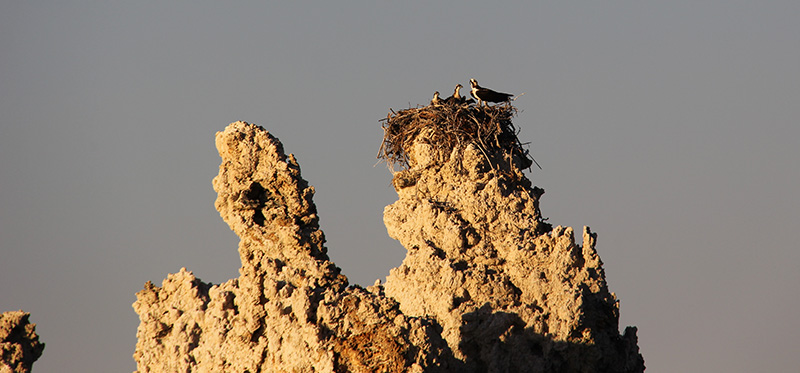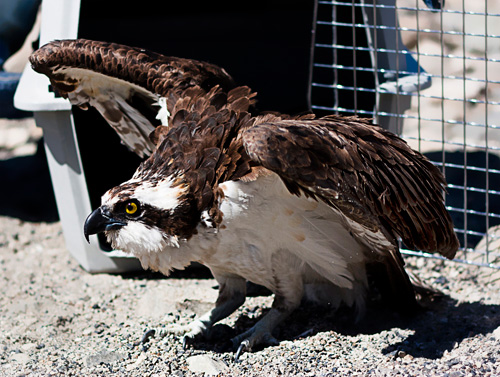
This post was written by Bryce Tiernan, 2013 Mono Lake Intern.
With a fresh dusting of snow covering the Sierra Nevada, it seems like an appropriate time to talk about migration. More specifically: Osprey migration. While Mono Lake is probably most known for its nesting California Gulls, there is an ever-growing population of Osprey that nest at Mono Lake every summer.

Osprey are a relatively recent addition to the Mono Basin, with the first nesting pair sighted in 1985 and the first confirmed nesting success—two chicks—coming a few years later in 1989. Since then the Mono Lake population has blossomed, with a recorded high of ten nesting pairs this past summer!
Now, with the summer chicks having fledged over a month ago and the nights cooling off, we are seeing the Osprey leave Mono Lake and venture to warmer climates. Like any sensible creature, the Osprey are off to Mexico and beyond for the winter!
On September 4, 2013 one of the adult female birds outfitted with a GPS transmitter left Mono Lake and began migrating south. Her last known location was inland from the Gulf of Mexico California coastline, north of Mazatlan. In recent years researchers at Mono Lake have been able to band the chicks hatched here and outfit some birds, like this female, with a GPS tracker. This research is being made possible with funding from the Mono Basin Bird Chautauqua Jeff Maurer Research Grant, the Bodie Foundation, and private donations accepted through the Bodie Foundation.

Aside from the Osprey that nest at Mono Lake leaving for the winter, Osprey from farther north are also migrating through the Mono Basin. This past week here at the Mono Lake Committee, we got to participate in the rescue of one such Osprey. The Osprey had stopped at Grant Lake Reservoir to fish and accidentally ate a fish that had already been caught. The bird had ingested a hook and line along with its fish and then had become tangled in the line and was unable to fly. The bird was rescued by Interpretive Ranger Dave Marquart and taken to Eastern Sierra Wildlife Care for treatment. The Osprey was able to make a terrific recovery and was re-released at Grant Lake Reservoir to continue its migration south.

Great story! Did I miss out on the continuing story of the banded gull that had been visiting Mono Lake for something like 25 years? Did she come back this year? Thanks..
Doug
The osprey is my favorite raptor! I used to watch them nest in the Grand Canyon of the Yellowstone when I worked as a summer ranger at Yellowstone National Park. I’m delighted to learn they have discovered Mono Lake. Happy osprey-watching!
I enjoyed this and look forward to updates about the osprey’s return.Thank you!
10 nesting pairs?! 10?1 WOW! I knew there have been 2 or 3 or so, but…
They all can’t be nesting on the tufas in the lake are they?Are some in the surrounding trees/forest?
Great story about the rescue!
Thanks,
Hank
Great that you rescued an Osprey, I see them on the coast, and inland, even heard and saw them when I was just there near Mono Lake recently. In fact I am painting one too. Glad that ESWC was able to rescue it, they tried to save a Red Tail a few years ago I had brought down from the mountains after having it fall nearly at my feet from a peregrine attack. Thanks, Val
At Mono Lake they are indeed ALL nesting on offshore tufa towers. Some of the nests fairly close to each other.